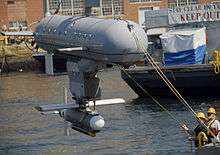Minehunter


A minehunter is a naval vessel that seeks, detects, and destroys individual naval mines. Minesweepers, on the other hand, clear mined areas as a whole, without prior detection of mines. A vessel that combines both of these roles is known as a mine countermeasures vessel (MCMV).
Description
A minehunter uses an imaging sonar to detect and classify targets and then sends out divers or remotely operated vehicles to inspect and neutralise the threat, often using small charges that are detonated remotely.
As minehunters will often be operating in close proximity to mines, they are designed so as to reduce their own acoustic and magnetic signatures,[1][2][3][4] two common forms of trigger for mines. For example, they are often soundproofed by mounting machinery on shock absorbers or by using quiet electrical drive,[5] low magnetic electric motors[6] and usually have a wood, fiberglass or non-ferrous metal hull, or are degaussed to reduce magnetic signature.[7]
Minehunters are generally small, shallow-draught vessels, as they are often called upon to work in enclosed bodies of water such as shipping channels or harbours. As manoeuvrability in such areas is critical the Voith-Schneider cycloidal propulsor is commonly used, allowing the engine thrust to be transmitted in any direction. A number of modern vessels use catamaran hulls to provide a large, stable working platform with minimal underwater contact; this reduces draught whilst lowering acoustic transmission and reducing the fluid pressure generated by the moving hull that may otherwise detonate mines with a hydraulic pressure trigger.
See also
References
- ↑ Holmes, John J. (2006). Exploitation of a Ship's Magnetic Field Signatures. Morgan & Claypool Publishers. ISBN 9781598290745.
- ↑ Holmes, John J. (2008). Reduction of a Ship's Magnetic Field Signature. Morgan & Claypool Publishers. ISBN 9781598292480.
- ↑ MAGNETIC SILENCING REQUIREMENTS FOR THE CONSTRUCTION OF NONMAGNETIC SHIPS AND CRAFT (METRIC), Department of Defense
- ↑ B. Froidurot, L.-L. Rouve, A. Foggia, J.-P. Bongiraud, G. Meunier (2002). "Magnetic Discretion of Naval Propulsion Machines" (PDF). Institute of Electrical and Electronics Engineers. Archived from the original (PDF) on 2017-09-06.
- ↑ Cope, C. (1996). "Low Magnetic Signature Propulsion System" (PDF). Engineering Matters.
- ↑ Hasper, H. ""Reduction of Magnetic Strayfield from Squirrel-cage Induction Motors", COMBIMAC document, 02 91". Institute of Electrical and Electronics Engineers.
- ↑ Design Guide and Requirements for Equipment to Achieve a Low Magnetic Signature, Ministry of Defence.
